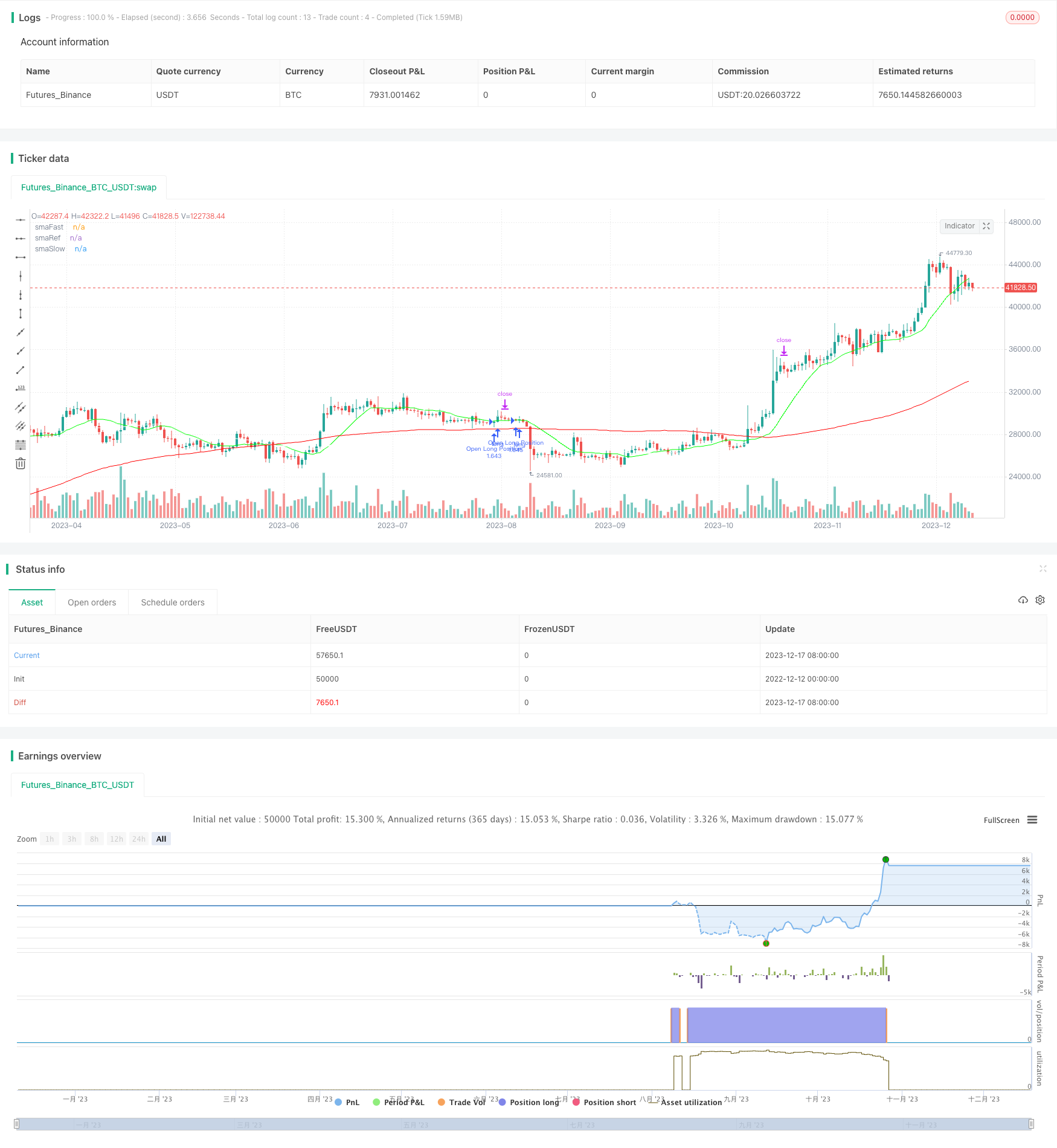
SMA波动偏移交易策略
策略概述
该策略利用简单移动平均线和一些数学计算来确定买入/卖出点。我们使用100天SMA作为基准线。如果收盘价低于该线,我们根据低于该线的程度选择开仓点,这个值(低偏移量)是一个可配置的百分比。对于平仓,如果收盘价高于我们的100天SMA,我们确定在何时卖出之前的偏移量。如果我们试图太早卖出(价格仍在上涨),追踪止损会启动。
策略原理
该策略使用三条SMA线:快线(默认14天)、慢线(默认100天)和参考线(默认30天)。
当收盘价低于参考线,并且相对于慢线的低偏移量大于配置的低偏移量时,且快线上涨而慢线下跌,进入多头。当满足这些条件时,快线和慢线极有可能交叉,因此是一个较好的入场点。
当收盘价高于参考线,并且相对于慢线的高偏移量大于配置的高偏移量时,且收盘价已连续3根K线上涨,已实现盈利,且快线高于慢线时,平仓多单。如果价格继续大涨,追踪止损会启动。
每次交易的头寸根据权益的一定比例进入,通过这种方式控制仓位。
策略优势分析
- 利用SMA的优势,即平滑价格曲线,过滤市场噪音。
- SMA交叉具有一定的预测趋势能力。
- 相对于SMA线设置偏移量,避免假突破。
- 结合趋势和交叉指标,提高决策的准确性。
- 利用追踪止损锁定盈利,避免回撤。
策略风险分析
- SMA本身滞后性较强,可能错过价格转折点。
- 偏移量设置不当可能导致过于激进或者过于谨慎。
- 追踪止损参数设置不当可能过早止损或者止损幅度过大。
- 无法应对价格剧烈波动的市场。
对应优化措施:
1. 结合其他先行指标过滤入场。
2. 对偏移量进行反复测试优化。
3. 对止损参数进行反复回测找到最优参数。
4. 在高波动阶段降低仓位。
策略优化方向
- 测试不同周期的SMA寻找最优参数
- 加入其他指标判断市场结构和趋势
- 优化追踪止损参数以锁定更多盈利
- 根据市场波动程度调整仓位
- 同时应用于多种品种并进行组合
总结
SMA波动偏移交易策略通过设定偏移量参考不同的SMA均线,寻找最佳入场时机。同时,退出机制设定了追踪止损来锁定收益。该策略简单易懂,容易实施。通过优化SMA参数、偏移量设置、止损水平等,可以获得更好的效果。该策略适用于中长线周期,追求稳定盈利的投资者。
策略源码
/*backtest
start: 2022-12-12 00:00:00
end: 2023-12-18 00:00:00
period: 1d
basePeriod: 1h
exchanges: [{"eid":"Futures_Binance","currency":"BTC_USDT"}]
*/
// @version=4
// Author: Sonny Parlin (highschool dropout)
strategy(shorttitle="SMA+Strategy", title="SMA Offset Strategy",
overlay=true, currency=currency.USD,
initial_capital=10000)
// Inputs and variables
ss = input(14, minval=10, maxval=50, title="SMA Fast (days)")
ff = input(100, minval=55, maxval=200, title="SMA Slow (days)")
ref = input(30, minval=20, maxval=50, title="SMA Reference (days)")
lowOffset = input(0.001, "Low Offset (%)", minval=0, step=0.001)
highOffset = input(0.0164, "High Offset (%)", minval=0, step=0.0001)
orderStake = input(0.96, "Order Stake (%)", minval=0, step=0.01)
// SMA
smaFast = sma(close, ss)
smaSlow = sma(close, ff)
smaRef = sma(close, ref)
distanceLow = (close - smaSlow) / close
distanceHigh = (close - smaSlow) / close
// Set up SMA plot but don't show by default
plot(smaFast, "smaFast", color=#00ff00, display = 0)
plot(smaSlow, "smaSlow", color=#ff0000, display = 0)
plot(smaRef, "smaRef", color=#ffffff, display = 0)
// The buy stratey:
// guard that the low is under our sma low reference line by our lowOffset %,
// default is 0.001. (low < smaRef) and (distanceLow > lowOffset)
// SMA fast is on the rise and SMA slow is falling and they are very likely
// to cross. (rising(smaFast,1)) and (falling(smaSlow, 1))
enterLong = (low < smaRef) and (distanceLow > lowOffset) and (rising(smaFast,1)) and (falling(smaSlow, 1))
// The sell Strategy:
// Guard that close is higher than our sma high reference line by our
// highOffset %, default is 0.0164. (close > smaRef) and (distanceHigh > highOffset)
// Guard that close has risen by 3 candles in a row (rising(close,3))
// Guard that we currently have profit (strategy.openprofit > 0)
// Guard that SMA fast is higher than smaSlow (smaFast > smaSlow)
// If it keeps going up past our close position the trailing stoploss will kick in!
enterShort = (close > smaRef) and (distanceHigh > highOffset) and (rising(close,3)) and (strategy.openprofit > 0) and (smaFast > smaSlow)
// Order size is based on total equity
// Example 1:
// startingEquity = 2000
// close = 47434.93
// orderStake = 0.45
// (2,000 × orderStake) / close = orderSize = 0.0189733599 = approx $900
// Example 2:
// startingEquity = 2000
// close = 1.272
// orderStake = 0.45
// (startingEquity × orderStake) / close = orderSize = 707.5471698113 = approx $900
orderSize = (strategy.equity * orderStake) / close
// Trailing Stoploss
// I'm using 1.35 as my default value, play with this for different results.
longTrailPerc = input(title="Trailing Stoploss (%)",
type=input.float, minval=0.0, step=0.1, defval=1.35) * 0.01
longStopPrice = 0.0
longStopPrice := if (strategy.position_size > 0)
stopValue = close * (1 - longTrailPerc)
max(stopValue, longStopPrice[1])
else
0
if (enterLong)
strategy.entry("Open Long Position", strategy.long, orderSize, when=strategy.position_size <= 0)
if (enterShort)
strategy.exit(id="Close Long Position", stop=longStopPrice)
//plot(strategy.equity)